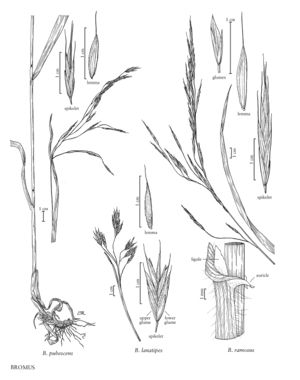Bromus lanatipes
Plants perennial; not rhizomatous. Culms 40-90 cm, erect; nodes 3-5(7), mainly pubescent; internodes mostly glabrous, puberulent near the nodes. Basal sheaths densely pilose or glabrous; upper sheaths glabrous or almost so, midrib of the culm leaves not abruptly narrowed just below the collar; auricles absent; ligules 1-2 mm, glabrous, truncate or obtuse, sometimes lacerate; blades 5-20 cm long, to 7 mm wide, flat, both surfaces glabrous, sometimes scabrous. Panicles 10-25 cm, open, nodding; branches ascending to spreading. Spikelets 10-30 mm, elliptic to lanceolate, terete to moderately laterally compressed, with 7-12(16) florets. Glumes usually glabrous, sometimes pubescent; lower glumes 5-6.5(7) mm, 1(3)-veined; upper glumes (6)7-9 mm, 3-veined, not mucronate; lemmas 8-11 mm, elliptic, rounded over the midvein, backs and margins pubescent, sometimes nearly glabrous, apices truncate or obtuse, entire, rarely emarginate, lobes shorter than 1 mm; awns 2-4 mm, straight, arising less than 1.5 mm below the lemma apices; anthers 1.8-4 mm. 2n = 28.
Distribution
Okla., Ariz., Colo., N.Mex., Tex.
Discussion
Bromus lanatipes grows in a wide range of habitats at 800-2500 m, from Wyoming through the southwestern United States to northern Mexico.
Selected References
None.
